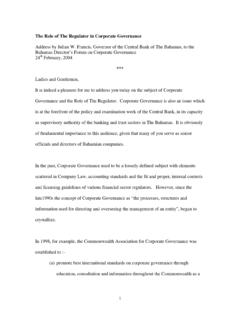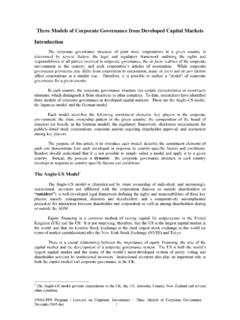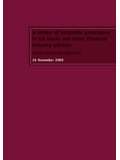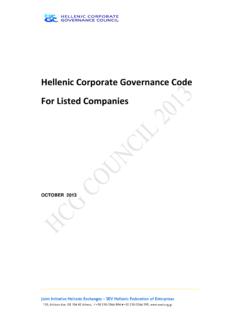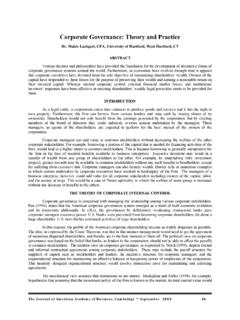Transcription of OECD Corporate Governance Factbook 2017
1 OECD Corporate Governance Factbook . 2017. OECD Corporate Governance Factbook 2017. Please cite this publication as: OECD (2017), OECD Corporate Governance Factbook 2017. This work is published under the responsibility of the Secretary-General of the OECD. The opinions expressed and arguments employed herein do not necessarily reflect the official views of OECD member countries. This document and any map included herein are without prejudice to the status of or sovereignty over any territory, to the delimitation of international frontiers and boundaries and to the name of any territory, city or area. The statistical data for Israel are supplied by and under the responsibility of the relevant Israeli authorities. The use of such data by the OECD is without prejudice to the status of the Golan Heights, East Jerusalem and Israeli settlements in the West Bank under the terms of international law. OECD 2017. Foreword The OECD Corporate Governance Factbook (the Factbook ) supports the implementation of good Corporate Governance practices by providing an easily accessible and up-to-date, factual underpinning for understanding countries' institutional, legal and regulatory frameworks Governments may use the Factbook to compare their own frameworks with that of other countries or to obtain information about practices in specific jurisdictions.
2 The Factbook compiles information gathered from OECD and non-OECD delegates to the OECD. Corporate Governance Committee as part of its ongoing work. The core information in the Factbook is taken from OECD thematic reviews covering how OECD and Financial Stability Board member jurisdictions address major Corporate Governance challenges that came into focus following the 2008 crisis: board practices (including remuneration); the role of institutional investors; related party transactions and minority shareholder rights; board member nomination and election;. supervision and enforcement; and risk management. Additional sections address the Corporate Governance landscape including ownership patterns, the role of stock exchanges and regulators, and the cross-border application of listing requirements. First published in 2014, the Factbook has been updated and expanded to cover 47 jurisdictions. This includes countries that the Corporate Governance Committee has reviewed as part of the accession process to become members of the OECD.
3 (As not every jurisdiction provided information for every table, in some cases summaries refer to a smaller number of jurisdictions.). The Factbook is divided into four main areas that are crucial for understanding how Corporate Governance functions in different jurisdictions: 1) the Corporate landscape; 2) the Corporate Governance framework; 3) the rights of shareholders and key ownership functions; and 4) the Corporate board of directors. These areas in turn are subdivided into 15 sub-topics. Each sub-topic has two parts: an overview of highlights and aggregate trends that emerge through a review of the more detailed and comprehensive tabular information that comprises the second part. The tables include information on the 35 OECD countries (now including Latvia which joined the OECD in 2016). to the extent available. Other jurisdictions covered include Argentina; Brazil; China, Colombia, Hong Kong, China; India; Indonesia; Lithuania; the Russian Federation; Saudi Arabia; Singapore and South Africa.
4 The information in this third edition of the Factbook is updated as of end 2016. This edition was prepared by Daniel Blume with the support of Akito Konagaya, Caio de Oliveira and other members of the Corporate Affairs Division of the OECD Directorate for Financial and Enterprise Affairs. 3. Preface This 2017 edition of the OECD Corporate Governance Factbook provides the first comparative report on Corporate Governance across all OECD, G20 and Financial Stability Board member jurisdictions. It now covers 47 different jurisdictions hosting 95% of all publicly traded corporations in the world as measured by market value. This makes the Factbook a unique source for monitoring implementation of the G20/OECD Principles of Corporate Governance around the world. It also supports informed policymaking by providing up- to-date information on the variety of ways in which different countries translate the Principles'. recommendations into their own legislative frameworks and markets.
5 Good Corporate Governance is not an end in itself. Instead, it is a means to create an environment of market confidence and business integrity that supports capital market development and Corporate access to equity capital for long-term productive investments. The quality of a country's Corporate Governance framework is therefore of decisive importance for the dynamics and the competitiveness of its business sector. The Factbook reveals that there has been a substantial evolution of regulatory frameworks. For example, 19 jurisdictions revised or issued new Corporate Governance codes during the last two years. Regulatory frameworks for risk management and remuneration policy -- two issues where the OECD identified weaknesses that contributed to the global financial crisis -- have been particularly dynamic, with the number of jurisdictions that have established requirements and recommendations related to these key issues increasing considerably.
6 As capital markets and corporations continue to evolve and new challenges arise, it is important for policy makers and regulators to stay abreast of how policies and practices can be adapted to remain effective under new circumstances. The Factbook can help them in that task. Angel Gurr a OECD Secretary-General 5. Table of Contents 1 The Corporate landscape .. 11. The ownership structure of listed companies .. 11. 2 The Corporate Governance 15. The regulatory framework for Corporate Governance .. 15. Cross-border application of Corporate Governance 28. The main public regulators of Corporate 34. Stock exchanges .. 45. 3 The rights of shareholders and key ownership functions .. 51. Notification of general meetings and information provided to shareholders .. 51. Shareholder's right to request a meeting and to place items on the agenda .. 55. Shareholder voting .. 59. Related party transactions .. 65. Takeover bid rules.
7 78. The roles and responsibilities of institutional investors .. 83. 4 The Corporate board of directors .. 93. Basic board structure and independence .. 93. Board-level committees .. 114. Board nomination and election .. 122. Board and key executive remuneration .. 131. Bibliography .. 139. 7. Figures Figure Examples of national Corporate Governance frameworks .. 15. Figure Custodians of Corporate Governance 16. Figure Implementation mechanisms of Corporate Governance codes .. 17. Figure National reports on adherence to the code .. 18. Figure Frequency and pattern of multiple cross-border listings .. 28. Figure The criteria for the exemption from local Corporate Governance requirements .. 30. Figure Who is the regulator of Corporate Governance ? .. 34. Figure How is the regulator funded? .. 35. Figure How is the ruling body of the regulator organised? .. 35. Figure Term of office of members of the ruling body .. 36.
8 Figure Largest stock exchanges by jurisdiction and group membership .. 45. Figure Market capitalisation of the 20 largest stock exchanges and groups .. 46. Figure Share of the market capitalisation of the 20 largest stock exchanges and groups .. 47. Figure Legal status of major stock exchanges .. 48. Figure Notification of general shareholder meetings .. 52. Figure Required media for publishing the shareholder meeting notification .. 52. Figure Deadline for holding the meeting after shareholder requests .. 55. Figure Minimum shareholding requirements to request a shareholder meeting and to place items on the agenda .. 56. Figure Issuance of shares with limited or no voting rights .. 59. Figure Formal vote counting and disclosure of the voting results .. 60. Figure Regulatory frameworks for related party transactions .. 65. Figure Disclosure of related party transactions in financial statements .. 66. Figure Board approval for certain types of related party 66.
9 Figure Shareholder approval for certain types of related party transactions .. 67. Figure Takeover bids rules .. 78. Figure Ex-ante or ex-post mandatory takeover bid rules .. 78. Figure Key thresholds for mandatory takeover bids .. 79. Figure Requirements for minimum bidding price in mandatory takeover bids .. 79. Figure Disclosure of voting policies and actual voting records by institutional investors .. 84. Figure Existence and disclosure of conflicts of interest policies by institutional investors .. 85. Figure Stewardship and fiduciary responsibilities of institutional investors .. 86. Figure One-tier, two-tier, optional or hybrid? .. 93. Figure Maximum term of office for the (supervisory) board members before re-election .. 94. Figure Minimum number or ratio of independent directors on the (supervisory) board .. 96. Figure Board independence requirement or recommendation and ownership structure .. 97. Figure Separation of CEO and chair of the board in one-tier systems.
10 98. Figure Definition of independent directors: independence from substantial shareholders .. 99. Figure Definition of independent directors: maximum tenure .. 100. Figure Board-level committees .. 114. Figure Independence of the chair and members of board-level committees .. 115. Figure Board responsibilities for risk management .. 116. Figure Implementation of the internal control and risk management system .. 116. Figure Board-level committee for risk management .. 117. Figure Majority voting requirement for board election .. 122. Figure Cumulative voting .. 122. Figure Qualification requirements for board member candidates .. 123. Figure Information provided to shareholders regarding candidates for board membership .. 124. Figure Criteria for board and key executive remuneration .. 131. Figure Specific requirements or recommendations for board and key executive remuneration .. 132. Figure Requirement or recommendation for shareholder approval on remuneration policy.










